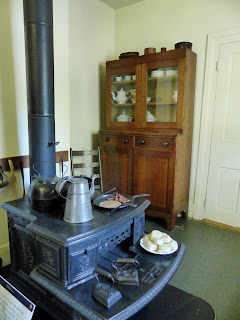 The RV and MH Hall of Fame and Museum is in Elkhart, Indiana, which is the RV Capital of the World. Apparently at one time it was the Manufactured Home Capital of the World too because that's what the MH in the name stands for. (There was a test when we came in, and I failed. The guy at the reception area asked if I knew what MH stood for and I said it was for Motor Homes. Pretty sure that's what 99.9% of all visitors would think.)
The RV and MH Hall of Fame and Museum is in Elkhart, Indiana, which is the RV Capital of the World. Apparently at one time it was the Manufactured Home Capital of the World too because that's what the MH in the name stands for. (There was a test when we came in, and I failed. The guy at the reception area asked if I knew what MH stood for and I said it was for Motor Homes. Pretty sure that's what 99.9% of all visitors would think.)There's an elk in American RV camouflage standing outside. (I cannot think of any place a red, white and blue animal wouldn't stand out--and I don't think the wheels would make it any easier to maneuver than most RVs.)
After a little intro on what was where, we started to explore. The first exhibit hall is called "Go RVing Hall", and it's sponsored by the Go Rving Coalition of manufacturers, suppliers, dealerships and campgrounds. They actually have a pretty good web site. So the first room is commercial, but generically commercial. My favorite display was the model of an RV Assembly Line. (Since we've gone to the Heartland Factory and seen all this, I could actually follow it all.)
Since we've gone on RV factory tours before, we skipped the movie and headed to the museum, which they call the "RV Founders Hall". (I have no idea why. We found RVs, but no Founders.) I had no idea there were travel trailers pulled by Model T's!
This Earl Travel Trailer was custom made for a Cal-Tech professor in 1913 and is the oldest travel trailer in the world!!! Wow! It's in really good shape for being over 100 years old. (You can't tell in the museum or in most of our pictures, but the Model T is really blue, not black--the sign says it was the last year that Ford offered any color except black. George thought it was a setting on my camera.)
They even had tent trailers in the early days of RVing! I thought that was a much later idea. This is a 1916 Cozy Camp Tent Trailer. (George doesn't look very cozy in this picture, but I managed to delete the one without him in it, so this is what I've got.)
This is a 1935 Covered Wagon Travel Trailer. Covered Wagon was the largest trailer manufacturer in the country at that time. Cute name, but it's a stretch to think it looks like a covered wagon.
On the other hand, the 1929 Covered Wagon does look like a covered wagon, even if it's a tent trailer masquerading as a covered wagon. Apparently all these folks were related to pioneers.
Wow! This one's so shiny it's hard to see where the trailer is. It's a 1935 Bowlus Road Chief designed by a sailplane engineer. Airstream took over the design a year later, and removed the boat-tail feature (which actually looks pretty dorky and would be a pain to live with, although I suppose you could put the kids or pets in there).
The tiniest Airstream I've ever seen is this 1958 Airstream Der Kleine Prinz. It was a prototype and never went into production. Still looks like an Airstream. (My mind boggles when I think of George trying to get into this thing, let along live in it!)
The path through the museum is fairly easy to follow, even if I did sometimes get into a cul-de-sac, and had to backtrack. This is not an unusual occurrence for me, so I didn't even consider myself lost.Besides travel trailers and tent trailers, there were self-contained motor homes too. They didn't call them motor homes in the beginning--they called them "housecars". Here's the 1937 Hunt Housecar:
...and the 1931 Model AA Ford Housecar:
This is the final working prototype for the 1985 Fleetwood Bounder that changed the motor home industry by putting basement storage in Class A motor homes. We've got that in our 5th wheel.
And just in case you question the part about MH standing for "Manufactured Homes" rather than Motor Homes--they've got an exhibit out back...
While you're in town, be sure to take a tour at the Heartland Factory or any of the other RV factories around Elkhart, and see how an RV (Recreational Vehicle) is made. The one above probably costs less than the one below.
More pictures from the RV & MH Hall of Fame.


















































